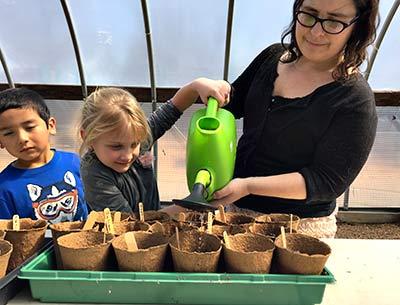Growing More Than Just Vegetables

The watering can was too heavy for any one student to lift on his or her own, but guided by the steady hands of their garden teacher, Springs School kindergartners learned how to water newly planted violas last Thursday.
Later this spring and through the summer and fall, seeds planted in Springs will grow into flowers, vegetables, and herbs that will be used in several ways. After-school clubs will learn how to cook with the fresh produce, and teachers will plan a school-wide salad lunch using the garden’s bounty. A plant sale scheduled for May 30 will help raise money to support the self-sustaining garden program, dubbed Springs Seedlings. Another idea is to set up a farm stand for the older students to learn the business side of gardening, and some of the leftover produce will go home with the students.
Hailey London, the school’s garden educator and greenhouse manager, said the Springs garden “is a seamless part of the school experience.”
“It’s an outdoor classroom that serves to help reinforce the science education going on in the school, and to enhance the kids’ nutrition knowledge and food understanding,” Ms. London said. “It really is a meaningful part of many of the grades’ learning. It helps them connect to where their food is coming from.”
In a region already known for its farming industry, schools are increasingly looking toward on-campus gardens for hands-on education and fresh produce to nourish both their students and the surrounding community. Partnerships with community members, businesses, local farms, and nonprofit organizations are part of the equation, helping to maximize the benefits of school gardens — often called edible school gardens.
In fact, the Springs program is just one such example. According to the Bridgehampton nonprofit Edible School Gardens, schools in Amagansett, Sag Harbor, East Hampton, Bridgehampton, Montauk are among those with thriving edible gardens.
In Bridgehampton, a group of parent volunteers meets every Monday at noon to maintain the school’s greenhouse and garden. Their work will supplement what the students are able to do during classes and when after-school clubs meet to plant, water, and harvest. The bulk of the food goes directly to the school’s kitchen, where the staff advises teachers and volunteers on the types of produce the kitchen can use. Bridgehampton’s greenhouse is currently growing mixed greens and sugar snap peas.
Kat McClelland, a parent volunteer and Bridgehampton School Board member, said helping in the garden is really fulfilling.
“We’re really making a difference in what the kids eat,” Ms. McClelland said. “Also, the East End of Long Island has such deep history in farming. It’s important for the kids to understand that.”
In many cases, students, parents, and community volunteers need not have extensive gardening experience in order to contribute to the life of the gardens and greenhouses. Ms. McClelland said Judiann Carmack-Fayyaz, a Bridgehampton teacher, is guiding them as they go along.
In Montauk, Donna Di Paolo, a teacher, said students have lately been busy turning the ground over and getting ready to plant. Last year, a tomato grown in the Montauk school garden won third place in an Island-wide tomato contest hosted by the Old Bethpage Village Restoration. The school’s greenhouse, which Ms. Di Paolo said has been around for 30 years, was recently renovated and dedicated to the late Carol Morrison, a founding member of Concerned Citizens of Montauk.
According to Edible School Gardens, the Hayground School was among the pioneers of school gardens, with a program started 12 years ago. The late Jeff Salaway “had a dream of the entire school sharing a meal from the school garden.” Later, a culinary building named for him — Jeff’s Kitchen — was built at the Hayground campus.
At East Hampton’s John M. Marshall Elementary School, Karen Defronzo, a teacher who coordinates the garden club, has the children planting lettuce, kale, peas, and marigolds in recycled plastic containers turned into “mini greenhouses.” She plans to make kale and fruit smoothies for the kids using what they grow, and hopes to start a farm stand in the lobby for parents to browse when they come to pick up their children. Ms. Defronzo also said East Hampton High School also has a robust garden program.
“It’s important, I feel, to start them young to take an interest in gardening, and then that should carry through to their older years,” she said. “The kids seem to really enjoy it. . . . I’m really looking forward to working with them and seeing their reactions when they see what they planted in these little mini greenhouses.”
Edible School Gardens will host its primary fund-raiser on Sunday between 4 p.m. and 7 p.m. at Dodds and Eder in Sag Harbor. Ms. Carmack-Fayyaz, the chairwoman of the organization, said the group hopes to raise money for programs that connect professional farmers and chefs with the schools as well as for “mini grants” for individual teachers and schools.
Ms. Di Paolo said she has observed students “expressing joy about being outside and working with the soil.”
“I always notice that they’re really motivated,” she said. “They’re using extra physical energy when they’re working — more than when they’re tackling a workbook.”
“There are so many lessons to be learned in the garden from the importance of nurturing something from start to end, to stewardship and personal responsibility. A school garden provides a space where academic concepts can be applied in real time in a real-world situation,” Ms. Carmack-Fayyaz wrote in an email. “There is nothing more satisfying and rewarding than seeing the fruits of one’s labor. In a garden, you get that experience; you come to understand within a growing season that effort and investment pays off richly, that challenges are many and that many hands make light work.”
